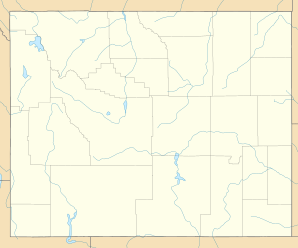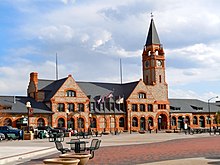Cheyenne, Wyoming
| Cheyenne | ||
|---|---|---|
| Nickname : Magic City of the Plains, Capital City (of Wyoming), The Frontier City | ||
 Wyoming State Capitol (2014) |
||
| Location in Wyoming | ||
|
|
||
| Basic data | ||
| Foundation : | 1867 | |
| State : | United States | |
| State : | Wyoming | |
| County : | Laramie County | |
| Coordinates : | 41 ° 9 ′ N , 104 ° 48 ′ W | |
| Time zone : | Mountain ( UTC − 7 / −6 ) | |
|
Inhabitants : - Metropolitan Area : |
64,019 (as of 2016) 98,136 (as of 2016) |
|
| Population density : | 1,170.4 inhabitants per km 2 | |
| Area : | 57.9 km 2 (approx. 22 mi 2 ) of which 54.7 km 2 (approx. 21 mi 2 ) is land |
|
| Height : | 1848 m | |
| Postcodes : | 82001-82010 | |
| Area code : | +1 307 | |
| FIPS : | 56-13900 | |
| GNIS ID : | 1609077 | |
| Website : | www.cheyennecity.org | |
| Mayor : | Richard Kaysen | |
 Bird's eye view of Cheyenne, 1882 |
||
Cheyenne is the capital of the US state Wyoming . It is on the edge of the Laramie Mountains in Laramie County .
history
In 1865 Major General Grenville M. Dodge camped with his troops at the site of what is now Cheyenne when he was tasked with finding a suitable route for a railway line over the Laramie Mountains, the location being identified as a suitable settlement point.
When Dodge was appointed chief engineer of the Union Pacific Railroad two years later , he founded what was initially considered to be a provisional settlement on the site of today's Cheyenne. The first settlers settled there in July 1867 when the Union Pacific Railroad built a train station here. The city was named after the local Cheyenne people (actually Shey 'an' nah ), a group of the Algonquians .
Many settlers came by rail and soon the city had around 60 brothels and saloons . Along with the railroad workers, numerous traders and speculators came to the region who hoped for good business here. At the turn of the year 1867/68 Cheyenne already had 4000 inhabitants. As early as 1868, Cheyenne was named the capital of Laramie County, and a year later the city became the capital of the newly established Wyoming Territory.
From around 1870 Cheyenne rose to a center of cattle breeding , which produced especially for the European market, with numerous "cattle barons" coming to the area around Cheyenne from around 1880. From 1875 gold was also mined in the area around Cheyenne, which again drove many settlers to the region.
In 1890 Cheyenne, which now had around 10,000 inhabitants, was named the capital of the then state territory of Wyoming . In the same year the construction of the Wyoming State Capitol began. Even before the turn of the century, many cattle breeders in the region switched to keeping sheep, which were able to adapt to the given climatic conditions of Cheyenne much better than cattle. Sheep farming continues to play an important role in the Cheyenne area to this day. During the 20th century, Cheyenne increasingly developed into an industrial location.
Attractions
- Wyoming State Capitol
- Cheyenne Botanic Gardens
- Francis E. Warren Air Force Base
- Nagle-Warren Mansion
- Atlas Theater
- First Presbyterian Church
- First United Methodist Church
- St. Mark's Episcopal Church
- St. Mary's Catholic Cathedral
The National Park Service identifies three National Historic Landmarks for Cheyenne , the Wyoming State Capitol, Fort DA Russell and the Union Pacific Railroad Depot Cheyenne . A total of 55 buildings and sites in the city are registered in the National Register of Historic Places (NRHP) (as of April 12, 2020).
economy
The state sector is by far the largest employer in the city. For example, the US Air Force has many employees at Francis E. Warren Air Force Base . Another industry is the Burlington Northern Santa Fe and Union Pacific Railroad rail companies . Furthermore, the companies have Great Lakes Airlines and Taco John's headquarters in Cheyenne.
The Wyoming Tribune Eagle is published in Cheyenne .
traffic
Cheyenne is on Interstate Highways 25 , 80, and 180 . Cheyenne Regional Airport is also located in the city .
Demographics
| Population development | |||
|---|---|---|---|
| Census | Residents | ± in% | |
| 1890 | 11,690 | - | |
| 1900 | 14,087 | 20.5% | |
| 1910 | 11,320 | -19.6% | |
| 1960 | 43.505 | - | |
| 1970 | 41,254 | -5.2% | |
| 1980 | 47,283 | 14.6% | |
| 1990 | 50.008 | 5.8% | |
| 2000 | 53,011 | 6% | |
| 2010 | 59,466 | 12.2% | |
Cheyenne is still a center of cattle breeding (Cowboy Capital) today . The Frontier Days have taken place every year since 1897 , a festival with over 300,000 visitors.
religion
Cheyenne is the seat of the Diocese of Cheyenne . In addition to five Catholic churches, Cheyenne also has numerous Baptist , Episcopal , Lutheran , Methodist , Pentecostal , Presbyterian and independent churches - as in many places in the USA . The Mormons are also represented.
sons and daughters of the town
- Robert D. Carey (1878-1937), politician
- Mildred Harris (1901-1944), film actress
- Rensis Likert (1903–1981), professor and social researcher
- Gail O'Brien (1911-1978) American football player
- James M. Schopf (1911–1978), paleontologist and geologist
- Jim Siedow (1920–2003), actor
- Burnu Acquanetta (1921-2004), actress
- George Clayton Johnson (1929–2015), author and film actor
- Rink Babka (* 1936), discus thrower
- James Bergquist (* 1947), physicist
- Bill Flores (* 1954), politician
- Cynthia Lummis (* 1954), politician
- Janice Bolland (* 1966), racing cyclist
- James Johnson (born 1987), basketball player
- Brandon Nimmo (born 1993), baseball player
Twin cities
Sister cities of Cheyenne are:
-
 Taichung , Taiwan, since 1981
Taichung , Taiwan, since 1981 -
 Bismarck , North Dakota, since 1988
Bismarck , North Dakota, since 1988 -
 Lompoc , California, since 1989
Lompoc , California, since 1989 -
 Lourdes , France, since 1990
Lourdes , France, since 1990 -
 Voghera , Italy, since 2002
Voghera , Italy, since 2002 -
 Hammam Sousse , Tunisia, since 2006
Hammam Sousse , Tunisia, since 2006 -
 Waimea , Hawaii, since 2007
Waimea , Hawaii, since 2007
Movies
- The series Hell on Wheels plays from the fourth season mainly in the Cheyenne of the early days
Web links
Individual evidence
- ↑ a b c d City-Data.com: Cheyenne - History Accessed on September 16, 2012. (English)
- ↑ a b c Cheyenne, Wyoming Fact Sheet (2011): History ( Memento of August 29, 2013 in the Internet Archive ) Retrieved September 16, 2012 (English).
- ↑ Official website of the city of Cheyenne: History. Accessed September 16, 2012. (English)
-
↑ Search mask database in the National Register Information System. National Park Service , accessed April 12, 2020.
Weekly List on the National Register Information System. National Park Service , accessed April 12, 2020.
Listing of National Historic Landmarks by State: Wyoming. National Park Service , accessed April 12, 2020. - ^ Great Lakes Airlines
- ↑ Taco John's
- ↑ http://www.churchfinder.com/churches/wy/cheyenne
- ^ Website Cheyenne - Sister Cities



